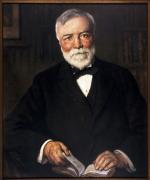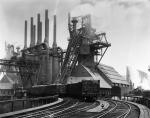![header=[Marker Text] body=[A poor Scottish immigrant, Carnegie became a millionaire steel magnate and proponent of the "Gospel of Wealth." Seeking to benefit society with his wealth, he built over 2,500 libraries and endowed institutions advancing education and peace. ] sign](http://explorepahistory.com/kora/files/1/10/1-A-1AB-139-ExplorePAHistory-a0b1o4-a_450.gif)
Mouse over for marker text
Name:
Andrew Carnegie [Railroad]
Region:
Pittsburgh Region
County:
Allegheny
Marker Location:
Carnegie Library, 4400 Forbes Ave., Pittsburgh
Dedication Date:
April 18, 1996
Behind the Marker
One of the giants of America's Age of Industry, Andrew Carnegie is remembered as the father of the American steel industry. A lesser well-known fact is that Carnegie began his career working for the Pennsylvania Railroad, and that he continued to invest in railroads the rest of his career. Arriving in America in 1835, this poor Scottish immigrant went to work in a telegraph office at the age of fourteen. Five years later, he caught the eye of Western Division superintendent Thomas Scott. Scott was so impressed by the young Carnegie that he hired him to be his personal secretary and telegrapher for the very satisfactory sum of $35 a week. "It was as though I was lifted to paradise," Carnegie later recalled. "I felt that my foot was upon the ladder and I was bound to climb."
I was bound to climb."
And climb he did. Still in his twenties, Carnegie invested his modest savings of $217.50 in the Woodruff Sleeping Car Company, which soon brought him annual dividends of $5,000. He succeeded Scott as division superintendent, (In 1874, Scott became president of the Pennsylvania Railroad) and began earning $1,500 annually. By the time he turned thirty, Carnegie was out of the railroad business; with substantial financial assistance from Scott, he started the Keystone Bridge Company, which aspired to replace wooden spans with newer versions made from iron and steel. Carnegie believed that steel was the industry of the future, and he began to focus on steel mill construction, access to raw materials, and beneficial transportation contracts.
While maintaining his connections with Scott, Carnegie started the Keystone Telegraph Company, receiving permission from PRR to string his lines along their tracks. He also invested with J. Edgar Thomson, in a variety of railroad ventures, including the construction of an impressive steel bridge over the Hudson River and the new Pittsburgh Locomotive Works.
J. Edgar Thomson, in a variety of railroad ventures, including the construction of an impressive steel bridge over the Hudson River and the new Pittsburgh Locomotive Works.
In 1874, Carnegie's first steel mill opened in Braddock, Pennsylvania, strategically located between the PRR and the B&O. Annoyed at the Pennsylvania Railroad for charging what he believed were excessive rates to carry his steel, Carnegie, in the mid-1880s, joined a group of investors to build an alternative rail route between Pittsburgh and Harrisburg, but work on the line was never completed. (More than a half century later the Pennsylvania Turnpike would be built on its unfinished track bed.) It was a rare setback for Carnegie. He later successfully built the Bessemer and Lake Erie Railroad to haul Mesabi iron ore from the Great Lakes to his Pittsburgh steel mills, and the Keystone Bridge Company built the line's massive 3,400 foot long bridge over the Allegheny River near Oakmont. Carnegie eventually oversaw the construction of rail lines connecting all of his steel mills.
Pennsylvania Turnpike would be built on its unfinished track bed.) It was a rare setback for Carnegie. He later successfully built the Bessemer and Lake Erie Railroad to haul Mesabi iron ore from the Great Lakes to his Pittsburgh steel mills, and the Keystone Bridge Company built the line's massive 3,400 foot long bridge over the Allegheny River near Oakmont. Carnegie eventually oversaw the construction of rail lines connecting all of his steel mills.
By the turn of the twentieth century, this onetime poor immigrant was one of the wealthiest men in the nation, though his accumulation of capital often came at expense to others. During the 1880s, for example, accidental deaths at Carnegie's immensely profitable Pittsburgh steel mills accounted for 20 percent of all male deaths in the city. Carnegie frequently tried to defend the vast discrepancy between his wealth and the earnings of his mill workers. In 1889, he argued that although the "operatives" working in mines and factories could not benefit from what he deemed the "onrush of civilization," this was a small price to pay for the overall good of society. Indeed, Carnegie contended, the "sacredness of property civilization depends [on] the right of the laborer to his hundred dollars in the savings bank, and equally the legal right of the millionaire to his millions."
Advocating the "Gospel of Wealth," he promoted the idea that wealth concentrated in the hands of a few wise individuals was the key to advancing the entire society. Though not everyone could benefit from the accumulation of personal wealth, he argued, the nation as a whole was improved by the successes of those who could. The "best interests of the race," Carnegie believed, were served by the efforts of innately talented men like himself, although this "inevitably gives wealth to the few."
"Gospel of Wealth," he promoted the idea that wealth concentrated in the hands of a few wise individuals was the key to advancing the entire society. Though not everyone could benefit from the accumulation of personal wealth, he argued, the nation as a whole was improved by the successes of those who could. The "best interests of the race," Carnegie believed, were served by the efforts of innately talented men like himself, although this "inevitably gives wealth to the few."
For more than a century, Carnegie has stood as a shining example of American "rags-to-riches" mythmaking; the poor-immigrant-made-good based on pluck and ingenuity, not to mention the good fortune to find a benefactor like Scott, who smoothed the path to riches for his young protege'. But Carnegie's legendary success story was the exception, rather than the rule.
A ruthless practitioner of corporate manipulation, Carnegie in his later years grew weary of the cutthroat competition of the steel and railroad business. He sold his share of his many companies to the J. P. Morgan backed U. S. Steel Company in 1904 for $300 million. From then, until the end of his life, Carnegie sought ways to dispense his fortune. The great industrialist evolved into the great philanthropist. The Carnegie Institute of Technology is one of the better known recipients of his generosity, and many large cities and smaller communities across Pennsylvania boast public libraries and museums originally constructed with his support.
Towards the end of his life, legend has it, Carnegie developed such a phobia about money that he was reportedly offended by the sight and smell of it, and he refused to carry any cash. By the time of his death, Andrew Carnegie had lived up to his personal dictum that "the millionaire is but a trustee for the poor." His foresight continues to yield generous cultural benefits for the citizens of the state of Pennsylvania.
One of the giants of America's Age of Industry, Andrew Carnegie is remembered as the father of the American steel industry. A lesser well-known fact is that Carnegie began his career working for the Pennsylvania Railroad, and that he continued to invest in railroads the rest of his career. Arriving in America in 1835, this poor Scottish immigrant went to work in a telegraph office at the age of fourteen. Five years later, he caught the eye of Western Division superintendent Thomas Scott. Scott was so impressed by the young Carnegie that he hired him to be his personal secretary and telegrapher for the very satisfactory sum of $35 a week. "It was as though I was lifted to paradise," Carnegie later recalled. "I felt that my foot was upon the ladder and
And climb he did. Still in his twenties, Carnegie invested his modest savings of $217.50 in the Woodruff Sleeping Car Company, which soon brought him annual dividends of $5,000. He succeeded Scott as division superintendent, (In 1874, Scott became president of the Pennsylvania Railroad) and began earning $1,500 annually. By the time he turned thirty, Carnegie was out of the railroad business; with substantial financial assistance from Scott, he started the Keystone Bridge Company, which aspired to replace wooden spans with newer versions made from iron and steel. Carnegie believed that steel was the industry of the future, and he began to focus on steel mill construction, access to raw materials, and beneficial transportation contracts.
While maintaining his connections with Scott, Carnegie started the Keystone Telegraph Company, receiving permission from PRR to string his lines along their tracks. He also invested with
In 1874, Carnegie's first steel mill opened in Braddock, Pennsylvania, strategically located between the PRR and the B&O. Annoyed at the Pennsylvania Railroad for charging what he believed were excessive rates to carry his steel, Carnegie, in the mid-1880s, joined a group of investors to build an alternative rail route between Pittsburgh and Harrisburg, but work on the line was never completed. (More than a half century later the
By the turn of the twentieth century, this onetime poor immigrant was one of the wealthiest men in the nation, though his accumulation of capital often came at expense to others. During the 1880s, for example, accidental deaths at Carnegie's immensely profitable Pittsburgh steel mills accounted for 20 percent of all male deaths in the city. Carnegie frequently tried to defend the vast discrepancy between his wealth and the earnings of his mill workers. In 1889, he argued that although the "operatives" working in mines and factories could not benefit from what he deemed the "onrush of civilization," this was a small price to pay for the overall good of society. Indeed, Carnegie contended, the "sacredness of property civilization depends [on] the right of the laborer to his hundred dollars in the savings bank, and equally the legal right of the millionaire to his millions."
Advocating the
For more than a century, Carnegie has stood as a shining example of American "rags-to-riches" mythmaking; the poor-immigrant-made-good based on pluck and ingenuity, not to mention the good fortune to find a benefactor like Scott, who smoothed the path to riches for his young protege'. But Carnegie's legendary success story was the exception, rather than the rule.
A ruthless practitioner of corporate manipulation, Carnegie in his later years grew weary of the cutthroat competition of the steel and railroad business. He sold his share of his many companies to the J. P. Morgan backed U. S. Steel Company in 1904 for $300 million. From then, until the end of his life, Carnegie sought ways to dispense his fortune. The great industrialist evolved into the great philanthropist. The Carnegie Institute of Technology is one of the better known recipients of his generosity, and many large cities and smaller communities across Pennsylvania boast public libraries and museums originally constructed with his support.
Towards the end of his life, legend has it, Carnegie developed such a phobia about money that he was reportedly offended by the sight and smell of it, and he refused to carry any cash. By the time of his death, Andrew Carnegie had lived up to his personal dictum that "the millionaire is but a trustee for the poor." His foresight continues to yield generous cultural benefits for the citizens of the state of Pennsylvania.








